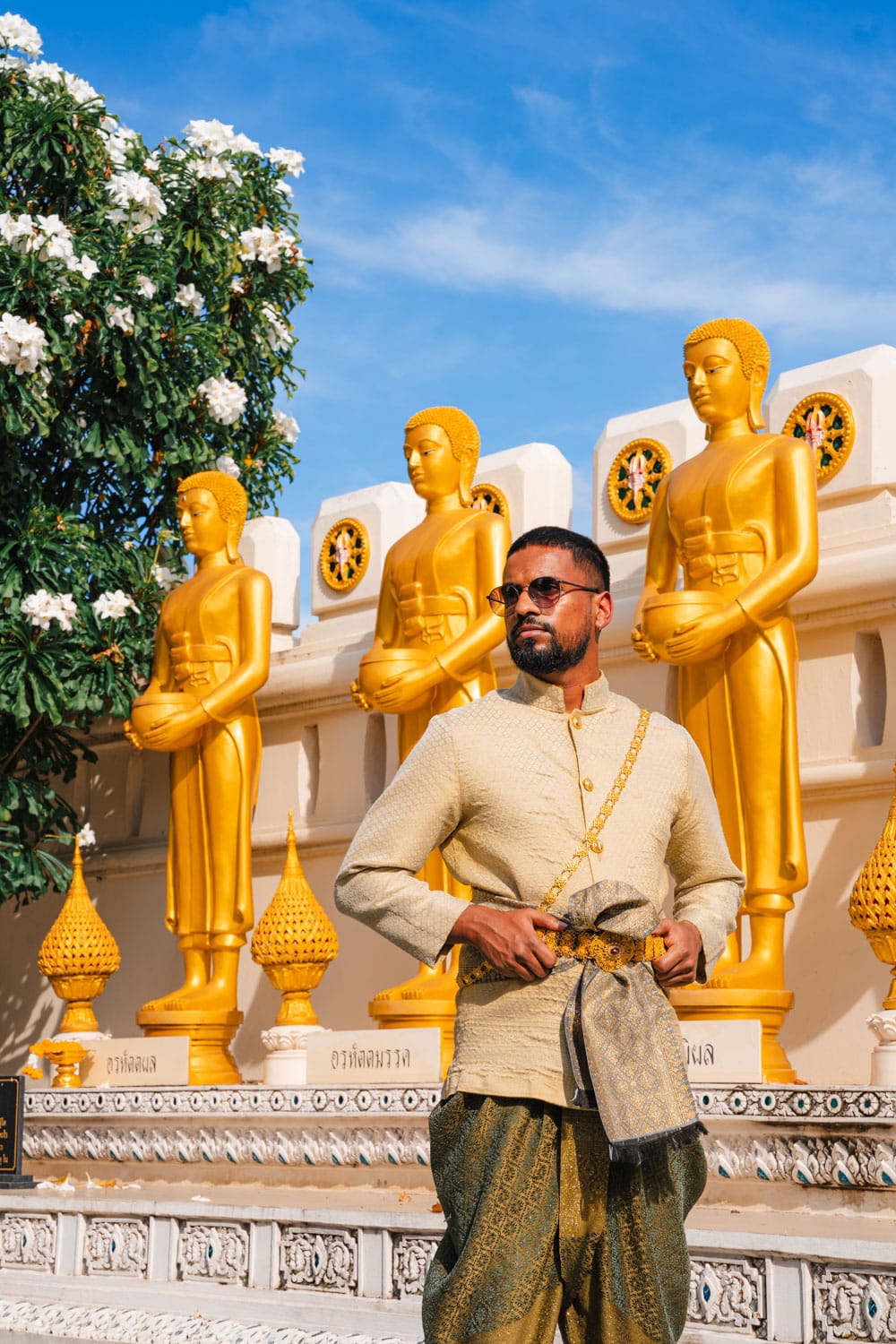The Tropical Climate of Thailand: A Defining Force in Fashion
Thailand’s tropical climate has always been a powerful influencer in the evolution of traditional Thai clothing, known as “chut Thai.” With temperatures often soaring above 30 degrees Celsius and humidity levels reaching up to 90% during the rainy season, Thai ancestors ingeniously developed garments that could provide comfort while maintaining cultural significance and aesthetic beauty. The traditional clothing wasn’t merely a fashion statement but a practical solution to navigate Thailand’s challenging weather conditions. When visiting Thailand, many tourists are surprised by the practicality behind the elegant Thai costume designs, which have been perfected over centuries to suit the local environmental conditions. This practical wisdom embedded in traditional clothing design demonstrates how Thai culture has always maintained a harmonious relationship with nature, adapting to its challenges rather than fighting against them.
The Fabric Selection: Natural Materials for Natural Comfort
One of the most remarkable aspects of traditional Thai clothing is the careful selection of fabrics. Before synthetic materials became widely available, Thai costume designers relied exclusively on natural fibers that were both locally available and suited to the climate. Cotton and silk became the predominant materials, each serving different purposes in the Thai wardrobe. Cotton, with its breathable nature, became the everyday choice for common people working in fields or going about daily activities. Silk, on the other hand, with its natural temperature-regulating properties, became the preferred material for royal and ceremonial clothing. Today, when you rent a chut Thai from specialists like SiamCrown, you can experience the comfort these natural fabrics provide, even in Bangkok’s intense heat. The tactile experience of wearing authentic Thai fabrics connects modern wearers to centuries of textile tradition that developed specifically to address climatic challenges while maintaining cultural identity through distinctive patterns and weaving techniques unique to different regions of Thailand.
Loose Silhouettes: The Genius of Thai Design Philosophy
The silhouette of traditional Thai clothing reveals much about the climate-conscious design philosophy behind chut Thai. Unlike Western clothing which often emphasizes body-hugging forms, traditional Thai costumes feature loose, flowing designs that allow air circulation around the body – a crucial feature in a hot, humid environment. Women’s traditional clothing often includes the “jongkraben” or “chong kraben,” a lower garment that involves wrapping fabric around the waist and drawing it between the legs to form a kind of loose trouser. This design allowed freedom of movement while maintaining modesty and providing ventilation. Similarly, the male “chong kraben” and later the wider fisherman pants (“kong kben”) embodied the same principles. These ingenious designs demonstrate how Thai costume designers understood the body’s need for cooling airflow centuries before modern climate-controlled environments. The loose silhouettes also allowed for ease of movement, making them practical for daily activities despite their often elaborate appearance when worn for ceremonial occasions.
Color Choices: Cultural Significance Meets Environmental Wisdom
The vibrant colors we associate with Thai traditional clothing weren’t chosen arbitrarily but reflect both cultural significance and environmental adaptation. In earlier times, before chemical dyes became available, Thai people created their fabric colors using natural materials – indigo plants for blues, turmeric for yellows, and various tree barks and insects for reds and browns. These natural dyes not only produced colors that harmonized with the surrounding tropical environment but also resulted in fabrics that didn’t trap heat like some synthetic dyes might. Additionally, lighter colors were often preferred for everyday wear, as they reflect rather than absorb the intense Thai sunlight. When you rent a thai costume from establishments like SiamCrown, you might notice this thoughtful balance between vibrant ceremonial colors and more subdued everyday tones in their collection. The color palette of traditional Thai clothing thus represents a sophisticated understanding of both aesthetic preference and practical adaptation to a challenging climate, creating a visual language that communicated both status and seasonal appropriateness.
Layering: Adaptability for Changing Conditions
Despite Thailand’s generally hot climate, temperatures can vary throughout the year, particularly in northern regions where evenings can become quite cool. Traditional Thai clothing addressed this variability through strategic layering. Rather than creating entirely different wardrobes for different seasons, Thai costume design incorporated elements that could be added or removed as needed. The sabai – a shawl-like garment worn across the chest or shoulders – served both decorative and practical purposes, providing an extra layer when needed or being adjusted for different levels of formality. Similarly, men’s traditional outfits often included optional jackets or shoulder cloths that could be donned for ceremonial occasions or cooler weather. This adaptability remains relevant today, as modern wearers of chut Thai navigate between air-conditioned indoor spaces and warm outdoor environments. The thoughtful layering system in traditional Thai clothing demonstrates an understanding of microclimate management that predates modern environmental engineering concepts, yet achieves similar goals through elegant simplicity.
Regional Variations: Climate Differences Across Thailand
Thailand’s geography spans diverse climate zones, from the cooler mountains of the north to the tropical islands of the south, and these regional differences are reflected in traditional clothing variations. Northern Thai costumes (Lanna style) typically incorporate more substantial fabrics and occasionally include elements like the “teen jok” – decorative fabric pieces with dense, detailed weaving that provides additional warmth. Conversely, southern Thai traditional clothing often features lighter materials and sometimes fewer layers to accommodate the consistently hot coastal climate. Central Thai designs, like those from the ancient capital of Ayutthaya, represent a middle ground, adaptable to the region’s pronounced seasonal changes. These regional adaptations showcase how traditional Thai clothing evolved not as a single uniform style but as a responsive system attuned to local environmental conditions. When exploring thai costume rental options at places like SiamCrown, you’ll discover these fascinating regional variations that tell the story of Thailand’s diverse climatic experiences and how they shaped local cultural expressions through clothing.
Ceremonial vs. Everyday Wear: Climate Considerations in Different Contexts
The distinction between ceremonial and everyday traditional clothing in Thai culture often reflects different approaches to climate adaptation. Ceremonial chut Thai, worn for weddings, religious ceremonies, and royal occasions, might prioritize cultural significance and visual impact over maximum comfort, incorporating multiple layers and heavier decorative elements. These outfits were designed with the understanding that they would be worn for limited periods in controlled environments. By contrast, everyday traditional clothing prioritized practical comfort for extended wear in various weather conditions and during physical activity. This practical distinction continues today – visitors experiencing thai costume rental for tourism photographs or special events can appreciate the ornate ceremonial styles, while those seeking authentic experiences of daily Thai life might prefer the simpler, more climate-adaptive everyday designs. This dual approach to traditional clothing design demonstrates the sophisticated way Thai culture balanced practical needs with ceremonial importance, creating appropriate solutions for different contexts while maintaining consistent cultural aesthetic principles.
Evolution Through History: Climate Adaptation Across Political Changes
The evolution of traditional Thai clothing through different historical periods reveals continuing adaptation to climate alongside changing cultural influences. During the Sukhothai period (13th-15th centuries), clothing was relatively simple and primarily climate-focused. The Ayutthaya period (14th-18th centuries) saw increased foreign trade bringing new fabrics and techniques, though climate-appropriate designs remained central. The Rattanakosin period, beginning in the late 18th century, brought more formalized court dress but still retained the fundamental climate-adaptive principles in structure and material. During King Chulalongkorn’s reign (1868-1910), Western influences began affecting Thai fashion, though even these adapted Western styles were modified to suit Thailand’s climate, with lighter fabrics and more ventilated designs than their European counterparts. This historical evolution shows how Thai costume design maintained core climate-adaptation principles even while absorbing new cultural influences, demonstrating the fundamental importance of environmental comfort in Thai clothing philosophy throughout changing political and cultural landscapes.
Modern Adaptations: Traditional Wisdom in Contemporary Fashion
Today’s modern interpretations of chut Thai continue to honor the climate-conscious wisdom of traditional designs while incorporating contemporary elements. Fashion designers working with traditional Thai clothing often use modern, moisture-wicking fabrics that mimic the breathability of traditional materials while adding durability and ease of care. Contemporary thai costume rental establishments like SiamCrown offer traditional designs made with both authentic materials for purists and modern adaptations for practical everyday wear. Even in air-conditioned environments, the fundamental design principles of traditional Thai clothing – loose fits, strategic layering, and appropriate fabric choices – remain relevant for comfort. This continuing evolution demonstrates how the climate-adaptive wisdom embedded in traditional Thai clothing design transcends its historical context to offer practical solutions even in today’s changing environment. The persistence of these design principles across centuries of technological change speaks to their fundamental effectiveness in addressing the basic human need for comfort in a challenging climate.
Seasonal Celebrations: Traditional Clothing for Thailand’s Climate Cycle
Thailand’s traditional festivals throughout the year showcase how traditional clothing adapts to seasonal climate variations. During the hot season festivals like Songkran (Thai New Year), traditionally lighter versions of chut Thai were worn, often in breathable cotton with minimal layers to accommodate water activities and intense heat. For the cooler season festivities like Loy Krathong, more elaborate outfits with additional elements like shawls or sabai draped in different ways might be worn. The rainy season brought its own adaptations, with certain fabric treatments and clothing arrangements designed to dry more quickly after inevitable exposure to moisture. These seasonal adaptations in festival clothing demonstrate the sophisticated understanding Thai culture maintained about the relationship between climate cycles, celebration, and appropriate dress. Visitors experiencing traditional Thai festivals today can appreciate this seasonal wisdom by choosing appropriate thai costume rental options that match both the cultural significance and the climate conditions of each celebration, creating both an authentic and comfortable experience of Thai traditional culture.
Experience Authentic Thai Costumes for Yourself
Immerse yourself in Thailand’s rich cultural heritage by trying on these climate-adapted traditional outfits at SiamCrown. Located in the heart of Bangkok at 236 Soi Luean Rit, Chakkrawat, Samphanthawong, our extensive collection of authentic chut Thai allows you to experience centuries of climate-conscious design wisdom firsthand. Whether you’re attending a special event, planning a photoshoot at Bangkok’s beautiful temples, or simply want to connect with Thai culture, our thai costume rental service offers options suited to both your aesthetic preferences and comfort needs. Visit us between 8:00 AM and 4:30 PM to browse our collection, with return time by 6:00 PM. Can’t visit in person? Explore our options at siamcrown.com and book your perfect Thai traditional outfit in advance. Step into Thailand’s cultural history while staying comfortable in designs perfectly adapted to the tropical climate!



